Celia Lake's Blog, page 13
October 13, 2021
Neurodiversity and recent history
If you’ve read more than a couple of my books, chances are that you’ve noticed a number of them have characters who are what we’d now describe as neurodiverse.
Neurodiversity is a term that encompasses a lot of conditions or experiences of how people think and interact with the world. They can include a wide range of things we have some names for, and plenty of things we don’t. Some you’ve probably heard of include autism, ADHD or ADD, dyslexia, dyscalculia, or dyspraxia Tourette’s Syndrome and some mental health conditions. Some estimates suggest that 30-40% of people fall into at least one of these categories (there can be overlaps, which make statistics harder…)
There’s also a huge range of experiences and ways this shows up for people. Each and every person has a unique brain and set of life experiences. All sorts of factors like family support or expectations, educational support, professional support and guidance (if testing and/or medication is part of the picture) make a difference in what it means for an individual.
We also know that while the term ‘neurodiversity’ is quite modern (it was coined in the late 1990s by Australian sociologist Judy Singer), that neurodiverse folks have been part of the world since, well, there were people.
For example, John Donvan and Caren Zucker wrote In a Different Key: The Story of Autism, a history of autism. As part of their research they discovered records from the mid-1800s that pretty clearly describe what we’d call autism today, and they talk about some earlier examples where there are less thorough notes.
One theory about why we see more people with these diagnoses or identifications these days is that modern society is a great deal more complex. Most people are asked – as part of ordinary daily life – to deal with a huge range of different situations and stimuli and expectations.
These include plenty of different noises (traffic, sirens, background music in every store ….), bright lights, dealing both with people who are well-known and a lot of total strangers (especially in the kind of work often open to people who are either still in school or are figuring out what they want to do with their lives.)
Modern life often expects us to reach a certain level of skill with a huge range of things, rather than being focused on a small number. Just think about all the skills someone needs to be competent in for a high school diploma – not just the subjects themselves, but technology skills, a certain amount of social skill (all those group projects…), and often many other non-academic expectations like community service.
It’s a big difference to the historical past. Even fifty years ago, many (though certainly not all) people might live much or all of their life in their home area or around people they’d mostly known from childhood. Even people who travelled or emigrated often did it in a context where they knew people with them, or where a situation was entirely new and challenging for everyone. Or it had some sort of structure to the expectations. In those cases, working through the situation could be more transparent and shared by everyone.
In addition, some people have an easier time than others of interacting in neurotypical society (or seeming to work with those expectations, anyway). Others have a much harder time. For people where the effort of doing so isn’t obvious, others may not realise what’s going on inside their head. They may only talk about it with a few close friends or family members. They might not talk about it much with anyone at all.
In my booksAt this point, I’ve published five books that have neurodiverse characters. Three of them probably wouldn’t define themselves as being notably different from other people, but those experiences and how their minds work definitely shapes their interactions with the world and their stories.
On The Bias features Thomas Benton, who went into service in a great country house at age twelve. It’s clear from his comments several times in the book that he found the structure and clear expectations very reassuring. A country house ran rather like clockwork: each person had their set of duties and knew the expected standards they had to meet. Even the social interactions were laid out pretty clearly – who you socialised with below stairs, what you did on your afternoon off, what the next step in advancement would involve.
Benton eventually became a valet, and then was thrown into the chaos of the trenches of World War I. He did his best to become very competent at what he could control (he is, for example, extremely good at charms to heat up water – a comfort in the trenches.) Once he came into the sphere of Lord Geoffrey Carillon, there was someone he could look to (in a socially expected and structured way) for what he should be doing, and how to do it. At the same time, his attention to detail and a certain determined focus on his work meant he was a superb valet for an adventuring younger nobleman. He trusted Carillon would explain what was needed on the adventuring side, and then he set about making it happen.
Cadmus Michaels, in Seven Sisters is in somewhat of the same position. While he has his strong interests and his preferences for how things are done, he happened to be born into a life where those things fit with what was expected of him. Mostly. A man of his class and education is permitted a bit of eccentricity, after all. If the money is there, being a somewhat reclusive classicist is an entirely acceptable mould for a man. Even his time in the Colonial Service was largely expected, and a place where the needed skills and social expectations were well-known.
Gabe Edgarton in The Fossil Door is the exception in my list above. He – and his family – are quite clear his mind isn’t like most people’s. While Gabe doesn’t have a term like ADHD to work with, he knows he skitters around between ideas, that he’ll make startling choices. And he definitely should not be left entirely alone with his impulses without some moderating influence.
He was lucky enough to have parents who didn’t entirely understand how he thought, but who made sure he had the support to figure it out for himself. He didn’t go to tutoring school (common for people of his class and privilege). Instead various of the adults in his life made sure he got additional resources for learning. He bounces around too much from topic to topic to make friends easily, but in among people who also love the endless puzzle, he does fine. Better than fine.
Thesan Wain in Eclipse is possibly the character where it’s least obvious. When reading her point of view chapters, it becomes obvious that sometimes the world is too fast and too bright and too complicated for her to sort out right in the moment. Stars, her beloved field, are very far away and don’t generally move quickly at all. The others in her field tend to appreciate steady reliable work and a certain obsessive focus on detail.
However, if you were to ask her about it, I think she’d blink a lot. From inside her head, many of the things she struggles with are about issues of class, expectations she doesn’t fully understand (often related to class and social niceties), and the eternal question of dealing with widely varying students. That these things also are partly about neurodiversity, well… that’s why sorting this out gets complicated.
The last published work so far is Complementary, a novella about Elizabeth Mason, which makes it clear that she (like Gabe) is somewhere in this set of experiences. She is, perhaps, slightly less likely to fling herself out a window as a resolution to a problem. (Though compared to Gabe that’s not a high bar to get over.) But she is a tad impulsive, a very non-linear thinker and problem-solver, but capable of intensive focus. She’s also very used to working with people who tolerate or even admire her admittedly many quirks and preferences.
In Casting Nasturtiums, a novella due out in December 2021, Golshan Soltani also has what we’d call ADHD, and before that novella begins, has funnelled it into a mix of duelling, Materia training, and running a music hall with its endless challenges. When injuries during the Great War change what’s practical for him, he has to rearrange a whole lot of expectations about how to handle the bees in his head.
Why does this matter?As with much of my other writing, I want to write books where people like me, like my friends and loved ones, get to have romance and love. Where they get to have adventures and come safely home. (And have a home that is safe to come to…)
That’s as true when we’re talking about how someone’s mind works as their body.
I owe many things to my editor, Kiya Nicoll (an author in their own right), who is also a long-time friend. But I especially owe them a lot of thanks for helping me figure out how to best show the neurodiversity of my characters on the page. And also for nudging me to write this post in part to highlight Thesan, in particular, as a model of neurodiversity that often goes unremarked.
August 6, 2021
Sailor’s Jewel is out!
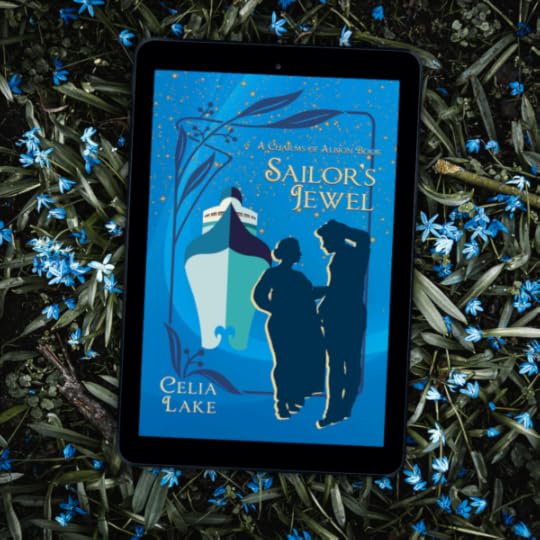
Sailor’s Jewel is set in 1901, during a November crossing of the Atlantic on The Moonstone, a luxury magical ocean liner.
Rhoe is about to take up a new and challenging position at the Temple of Healing. Her parents have persuaded Cyrus, her brother, to take her on one last pleasant voyage in hopes of changing her mind about a few of those commitments. Cyrus, a member of Albion’s Council, has his own worries, but he’s looking forward to a trip with the sister he rarely gets much time with.
Hugh Pelagius has been working his way up in the family business, learning all the pieces that go into every voyage. This trip, for the first time, his duties are to socialise with the first-class passengers and make sure everything goes smoothly.
When a magical jewel Cyrus is conveying to Boston causes problems, Rhoe and Hugh must work together with Cyrus and others to keep the ship safe and take care of everyone on board.
Get your copy now for pelagic mermaids, magical gems, and shipboard life:
Amazon Kindle Apple Books Barnes and Noble Nook Google Play Kobo Additional optionsWhere this book fits into my other stories:
As always, you can read my books in any order. Rhoe appears later in her life as a secondary character in Carry On, and Rhoe, Hugh, and Cyrus have all made an appearance in Eclipse.
Anything else you want to know?
You can check out my content notes page for some additional details.
May 23, 2021
Joy! People loving my books
I spent last night staring at my computer screen in utter delight (and a fair bit of ‘wait, is this real?’), due to the lovely comments on the latest Whatcha Reading? (May 2021, part 2) post from Smart Bitches, Trashy Books.
Thank you so much to Catherine and all the other commenters who’ve said such kind and glowing things about my books. I’m ecstatic that people have enjoyed them for all the reasons I hoped people would. I’ve been a reader at SBTB for many years (sometime before 2010), and it’s one of my go-to sites for discovering new books, with thoughtful commentary about a wide range of books.
The comments there did make it clear I really ought to add some information to my website, though.
If you’d like to try out my books, you can get my first book, Outcrossing, for free by signing up for my newsletter. (It’s my first book, and I’ve learned a lot about writing since then. I recommend Pastiche as a starting point to see what I think my books do best.)
New today:I have a page of questions and answers, talking about:
Reading order (see below)Where you can get my booksGetting my books from your libraryWhat helps me most as an authorFinding out about what’s coming nextWhy I’m (mostly) writing in the 1920sWhy disability representation is a thing I care about. Where to learn more about historical tidbitsWhat’s in my newsletter and why you might want to subscribeWhy my books aren’t in Kindle UnlimitedHow to get in touch if you have other questionsReading order:The question I’ve been seeing most is about where to start. Taken from that questions page, here’s my answer as of May 2021.
You can read my books in any order. (One note: I do recommend reading Goblin Fruit before you read On The Bias.)
If you’re someone who prefers internal chronological order, here’s a timeline . Start with Pastiche if you want to read just one of my books, and get a grand sense of what they’re like. Start with Carry On if you’d like to start with the current series. If you like a locked room murder mystery with your romance, try In The CardsIf you’re looking for particular kinds of stories, or want to avoid a particular topic, check out my content notes for more information about each book. I have a project in the works to make it easier to find out if a character you love appears in any other books.
May 7, 2021
An Eclipse changes everything
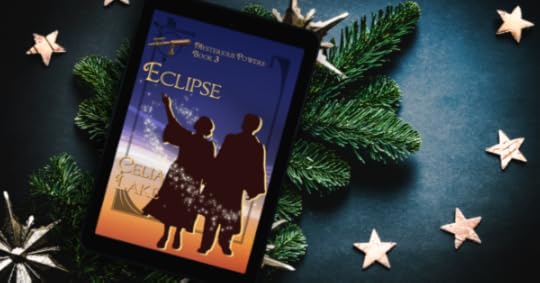
I’m so delighted to be able to share Eclipse with all of you.
Schola is the most elite of the magical schools of Albion, devoted to preparing the best and brightest young adults for a life of magic, innovation, and perhaps service. Students hurry from class to class, learning everything from writing to duelling, alchemy to astronomy.
Thesan is now established as the Astronomy professor, but is still one of the youngest and newest teachers at Schola. She is eagerly anticipating the upcoming eclipse, a rare event, as well as her usual classes and projects.
Isembard came to Schola last year to teach Protective magics and act as bodyguard and mentor to two sons of Council Members. He has settled into a pleasant life with a great deal of time in the duelling salle, and an amiable beer in the pub on Saturday evenings while he and Thesan mark assignments. This year promises to be even better, since Alexander, his own mentor, will be teaching Ritual classes.
No school year is ever simple. And it never goes the way you think it will.
Eclipse is full of astronomy, what makes a good teacher, student dramatics, glittering social events, academic politics, students who are possibly up to something, and whether a relationship might work between two people from very different backgrounds who have their own professional goals and expectations. Set in the 1924-1925 school year, Eclipse explores what it means to live, work, and love at Schola.
Get your ebook now from your favourite source. (Paperbacks coming soon: sign up for my mailing list to find out when they’re out.)
March 5, 2021
The economics of writing
An unusual post from me, but I found I had some blog-length things to say about a currently ongoing conversation on Twitter.
Short version: If you want to support an author:
Buy their books (or ask your library to)Tell other people about their books (leave a review, tell your friends, etc.)Support a reasonable copyright term that allows them to plan for the future and benefit over time from the work that has gone into the book. Me and my background:I am a self-published author of 10 books and counting. I am a librarian. I also have more education under my belt about copyright law and where it comes from than most lawyers who haven’t focused on intellectual property.
(I took the CopyrightX class in 2017: it is a by-application but free to take class offered by Harvard Law School. I did quite well on my final exam, thanks. You can access the lectures and readings on the course site, but much of the meat of the course comes from the discussion sections.)
I’ve been putting out a book every three months since the end of 2018, and I just had my best month ever in February 2021. Keep reading, and I’ll tell you what that actually means.
Disclaimer: I’m speaking in generalities about publishing here, except when I’m talking about my own personal numbers. Otherwise, this would be vastly longer.
The conversation:There’s been a lot of discussion on Twitter the last couple of days about changing the copyright term for written works. One of the things someone tossed out was limiting copyright to 30 years, or to the life of the author.
Both of these are incredibly damaging to authors and future works.
Books are a very long-tail business.
People come to books at different times, different paces. There are fashions in books and genres, and sometimes a genre will toddle along amiably for a decade or two, and then everyone wants more of that genre.
An author might have a whole string of “sure, that’s a fine book” and then have one book decades later that gets all the buzz (and all their previous books suddenly get a lot more interest and sales.)
In today’s media market, of a few super huge companies, there is a real risk that they will wait until the term expires, grab the property, and put out whatever they like. As opposed to the current system, where authors can choose to agree to options on their work or licensing, as they see fit.
Here’s Courtney Milan on the topic (romance author, and previously intellectual property lawyer) and here’s a thread from Ursula Vernon (a hybrid author). To give you a tase of the issues. And here’s my editor Kiya with several more important points.
(Note for Commonwealth country and European readers: the US does not have a moral rights clause in its copyright law. This means that after the creator sells the rights to publish, they do not have a say in what happens with the work after that. They may if they license, or if there’s some other contractual agreement.)
The current system is already abused (see the case of Alan Dean Foster, recently), but there are at least systems that avoid much of that. But you might see why creators are dubious about the idea the big corporations wouldn’t just take what they could, as soon as they can. We’ve seen it happening already.
Thinking about the long tailA lot of authors – trad published, self-published, and all the hybrid folks out there – rely heavily on backlist sales. Each time a new book comes out, you have potential for some new readers. If they discover your books (because you have included their favourite trope or setting or plot device, say), they might give the rest of your books a try, or mention it to someone else they know.
The other problem is that authors are not islands of their own. They may have kids (and may have kids who have disabilities or needs that will need ongoing care or support into their adult lives). They may have a spouse. They may have elderly parents (or other family) who rely on the extra income they get from the author.
If copyright expires when the author dies, what happens to all of those people? What happens to the book they spent a year or more on, that just came out, and has not earned much yet?
The work that goes into a book makes money over a long period of time, and that work should be valued in a way that supports the creator before anyone else. Books that were written fifty years ago can still be tremendously popular, or a hundred years ago (look at the Golden Age of Mystery authors…)
On a somewhat more pragmatic level, think about it as a reader. If an author you love gets a diagnosis of a medical issue that means they will die sooner than later, what incentive is there at that point for them to finish writing the book you’ve been waiting for? Why should they spend their time doing that, rather than with their family, or their friends, or whatever else they want?
(This is not at all hypothetical for me. My father died when I was 15, after a cancer diagnosis that gave him about a year to live. He was an academic who also wrote about 30 books over his career, including one novel. I’m very clear that copyright laws influenced his decisions to keep writing as well as spend time with us as a family. Various people (including his entire field of study) benefitted from that choice, and not just financially.)
A lot of people also don’t understand the mechanics of how a book makes money.
How authors make moneyTraditional publishingIn traditional publishing, generally the author writes a book, then the author and maybe their agent convince a publishing house to buy it. The most usual mode is that the publishing house pays an advance (a flat sum of money, usually in two or three payments that might stretch over a couple of years).
If the book eventually earns more than the advance, the author eventually get royalties (a split of the income, based on whatever’s contracted.) Note the ‘eventually’ here – the vast majority of books do not earn out the advance.
In return, the publishing house does the work of designing a cover, doing the book design, editing, and some degree of marketing, and distributing the copies. (The amounts of editing and marketing have been generally declining for the past decade or more.)
Advances are generally not big, especially when you look at that money being paid over a couple of years. Usually it’s something like the initial agreement to buy the book, when the completed version is turned in, and when the book comes out. Note that the author controls only one piece of this timing.
Jim C. Hines has been doing breakdowns of his own income and some conversation about trends in the science fiction and fantasy community, which may give you some ideas. Here’s his 2020 writeup with a lot of context for his own numbers.
Self-publishingI self-publish, which means basically all of the things that need to be done to make a book, I either do myself or hire someone to do (or trade skills for…) If I can’t pay for it, the thing doesn’t happen – even if that might well lead to better sales down the road.
There are lots of different approaches out there to self-publishing. Some people turn out a lot of books fast – maybe one a month, or even faster. Others take longer between books, but that can make marketing harder for all sorts of (often algorithm driven) reasons.
The people who make significant money are usually writing toward the middle of the genre, things that have the widest possible audience. In romance, this might mean shifter romances, billionaire romance, etc. The things that make the top of the sales charts, reliably, month after month. If you’re keeping an eye on what’s selling, and can turn out words reliably in that subgenre, and have an engaging writing style, substantial income is possible.
I know people who are having mid four figure to lower five figure (c. 5k to 20ishK) months on regular basis, usually noticeably higher in new release months. But to do that, they have to spend a lot of time and energy paying attention to details of what’s selling, adjusting accordingly. They usually spend a non-trivial amount of money on ads or on otherwise finding new readers. And frankly, they have to get lucky to get the traction that helps them get those sales.
There’s one other factor here: Kindle Unlimited versus what’s called “wide”. Self-published authors whose books are in Kindle Unlimited make an agreement that the ebook will be exclusive to Amazon. (Big publishing houses get different deals with Amazon.)
These books get additional money for the number of pages read each month. For most authors in Kindle Unlimited, that’s often a larger part of their income than direct sales.
For wide authors (like me), who want their books available on every ebook platform (which also means libraries can get them), you don’t get those page reads. I have to figure out how to tell people on all those different platforms that I have a book they might like.
There is no advance here for either kind of self-publishing. The only money I make from my books is when someone buys one, the vendor sells it, and eventually they send me money. I have no idea what that number might end up at. If I write a great book a lot of people love, maybe a lot. Maybe I write a great book that only a few people love, and it’s a lot less.
Let’s talk numbersFirst, I have a full time job. But I have a full time job as a librarian (not a super well-paid field) in a high cost of living city. I have some debt (including from the grad school required for my current job and from some health-related needs.)
I’m single and live by myself with the cat. I dream of a future in which I could buy a condo or townhouse and not worry about getting priced out of the rental market, or where I’d have some more financial reserves in general. I worry a lot about long-term financial stability. And I like to sometimes buy books, and music, and maybe travel every couple of years.
I hope that over time, writing will fill those gaps for me. We’re not there yet, even though I’m writing stuff that some people have really enjoyed.
Besides my writing and day job, I also do monthly data wrangling for a friend (on a ‘paid per hour’ basis), and occasional consulting (mostly organisational editing).
Publishing costsWhile actually writing the book doesn’t directly cost much money (I already have a computer, a keyboard, and my brain), there are a lot of costs involved with publishing, even if you do it relatively cheaply.
In my case, I hire my cover artist, do a trade of skills with my editor (a long-time friend), count my blessings for my early readers, and pay for a couple of services and tools to help the publishing parts go as quickly and smoothly as possible. When I can throw some money at it, I run some ads. I host this website. I have a big enough mailing list I’m no longer on the free tier. You get the idea.
If you think about this for a second, you’ll realise that every single book starts out costing me money (not just the time in which I might have been doing other things to earn money or save money).
TimeHow long it takes to write a book varies hugely – by person, and by book! It’s especially hard to count “was reading something totally different and had an idea that improves the book” or “background reading for something that might be a small detail in the book” or the traditional “I had an idea in the shower!”
I do track my time routinely, so I can tell you that to create The Fossil Door (my most recent book that’s come out), it directly involved:
About 90 hours of writing time (I average about 1000 words an hour), over the course of 90 days. 15 hours of focused editing time2 hours to write the blurb/cover copy and other material2 hours to upload for publication1 hour to set up this website for a new book2 hours for release notes (mailing list, social media)1 hour for follow up edits on the websiteTotal: 90 hours writing, 23 hours for everything else = 113 hours. It was almost certainly my easiest book to edit so far.
When I say books vary, I mean they can vary a lot. Eclipse (coming in May) is so far my most time-consuming. I’ve spent 39 hours editing it so far, and I expect to add at least 5 more.
I also spend probably 5-10 hours most weeks on various tasks across all of my books – things like blog posts, wiki notes, replying to emails, planning future promotions, reading things to improve my skills.
Now, I’m single, I don’t have kids, so while I have to do all the household stuff (or it doesn’t happen), I’m not juggling anyone else’s schedule.
My output is linked closely to the fact that I can spend two hours a night in writing time (I also write other things, for other purposes, usually when I need to think about the next thing in the novel in progress). It also means I can devote most of my Sundays to editing and other focused publishing-related time.
IncomeAs I said above, February 2021 was my best month yet. I have 10 books out, and I made $704.71. $317 of that was The Fossil Door, which came out at the beginning of the month. (Thank you so much to everyone who bought a copy or told people about it!) The rest was scattered through my other books, each of which sold at least 14 copies.
Each of the places through which I sell books takes a chunk of the sales price for their fee (usually 20-30%, depending on the site and agreements). Also key: I will not see most of the money for my February sales until the end of April.
When it hits my bank account, I will throw 50% into future expenses (those covers, ads, and other things that help me sell books, basically continuing to support book output and sales).
I will put 25% toward taxes (this is a bit higher than it needs to be but it makes doing the math on a dozen payment sources easier in my budget app. The usual recommendation for self-employment is 15% or so.
I set aside 25% for actual “I made a little money doing this, yay!” salary equivalent.
$704 is less than half a month’s rent on my apartment (I live in a Boston suburb because of where my library job is. Rents are high.) 25% of that – $176 – is not nothing. But it’s not going to pay much of my living expenses for the month.
For a brand new release, that means that so far (if we don’t try to calculate expenses specific to this book), that I’ve made about $2.80 per hour of active writing and editing time. (Not counting background reading, developing my skills as a writer, doing all the admin parts of the writing business, etc.)
And if we look at my actual ‘salary’ from that income, we’re talking more like $0.70 an hour.
Now, if I’m lucky, and people keep telling their friends about my books, those numbers will continue getting better. I hope so (because I want people to love my books!)
But if you look at it purely on a numbers perspective, it’s going to take a possibly rather long while for it to have made me as much as those hours would have done at my day job, never mind more.
Back to copyright(And the long tail of sales…)
So why would I spend my time writing, when I could be doing quite a lot of things that would make me more money? Well, partly because I do have stories I want to tell.
But it’s also because I hope that over time, as people find my books and continue to read them, people will buy more of them. I want to build up a steady income from that work, that will continue creating a great shared thing (I can keep writing more books, readers can keep reading them). But if that cuts off at some arbitrary point in my lifetime, that changes a lot of equations.
I think of Jane Yolen, who just had her 400th book come out (no, not a typo). She has a career spanning decades. (She’s 82 this year). Her work went into all the early books (as well as other people, who have benefited from salary or percentages, as suits. the role.) It doesn’t stop being her work and her effort, created by her particular unique brain, at some point determined from the outside.
And it also means we can take care of an author who had one really well known book, and a bunch of others that have had much smaller sales.
Because there’s the last part. If you’re relying on income from your writing, the copyright is the real thing you hold that gives any security. You don’t have a salary. You don’t have benefits from your job if you’re writing full time. You have to pay more in taxes (because there’s no employer paying some of them.) What do you do have is the premise that if people choose to buy what you wrote, what you created, that there will be something coming your way.
They might not buy next month or next year. What you write has to cover an indefinite future.
We can make that indefinite future a tiny bit more under the creator’s control with reasonable copyright limits. I’m fond of life+30 years or so for people. (Corporate copyright, sure, have a thirty year cut-off, or renewable terms.) But people have kids, have people relying on them, have unexpected things happen.
If you want people to create more things, give them hope of a future that treats them decently. Creativity works a lot better that way, for so so many people.
February 5, 2021
Come explore The Fossil Door!

When a recently established portal stops working in the Scottish Highlands in 1922, Rathna, a Portal Keeper, is assigned to figure out what happened. Gabe is assigned to assist her. Neither of them expect the challenges they find, the dangers of the local wildlife, or the way history and magic can come back to haunt you.
They’re both keeping secrets. Can they learn to trust each other, fix the portal, and move forward in the world?
Gabe is perhaps one of my favourite heroes so far – and a book set in the remote Scottish Highlands gives him plenty of scope to show off his skills and knowledge. Rathna is much quieter, the sort who looks before she acts, for all sorts of reasons.
(Sign up for my newsletter for a short character study about Rathna’s apprenticeship that I’ll be sending out in March 2021.)
December 10, 2020
Knitting for the war effort – Wristers
Knitting for the war effort during the Great War involved all sorts of things. Some were simple – wristlets and mufflers (scarves), and socks. (I admit, I am intimidated by knitting socks.) They also included more complex items, like gloves designed to allow for easy shooting of a gun, or caps to be worn under helmets.
Elen, the heroine of my latest book, Carry On, does a lot of knitting. I wrote in my last post about wartime knitting in general, but I wanted to give it a try myself.
So I spent a bit of time in late November knitting up a set of wristlets. (About 7 hours, all told.) Read on if you’re curious about knitting your own historical pattern.
An example
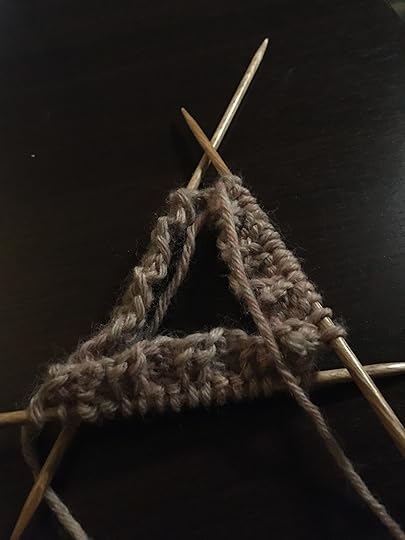
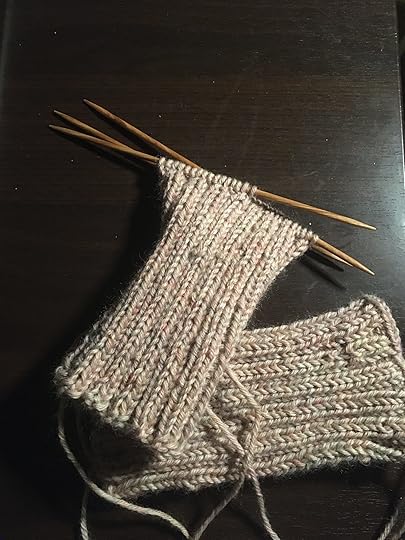
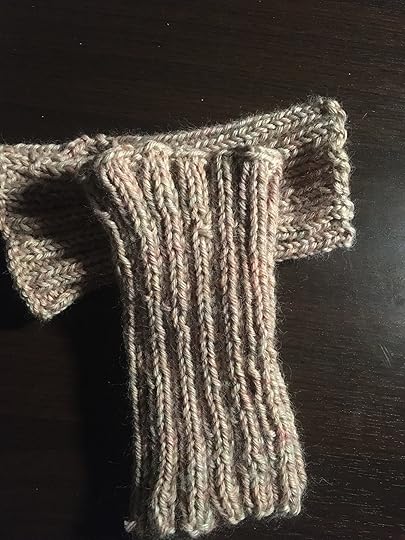
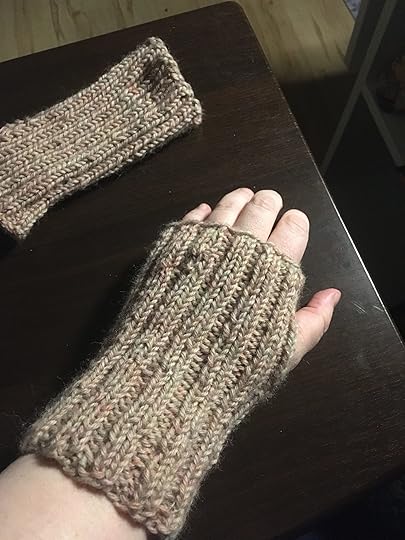
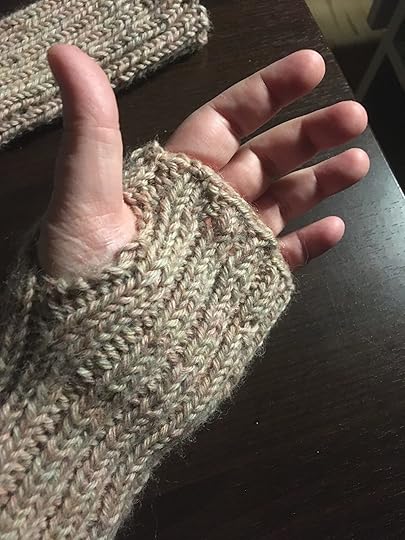
I ended up using a modernised pattern from Holly Shaltz, taken from a July 1917 issue of Modern Priscilla Magazine, using patterns from the American Red Cross. There are very similar patterns in British Red Cross guides too. Holly has patterns for a scarf there too.
British and American knitting needles are different sizes. Worse, needles during the Great War were also different from the sizes we used today. I was happy to use someone else’s guidance on an appropriate combination.
The yarn for these is in a colour suitable for wartime (not quite British khaki, but would not draw attention), Jagger Spun Heather in the Peat colourway. Basically any wool worsted-weight yarn should do for this.
My yarn comes from my local yarn shop, Mind’s Eye Yarns. Much thanks to the shop owner, Annie, who also consulted on some of the historical knitting here.
My adaptations and process
I have small hands, so instead of 20 stitches on a needle for a total of 60, I went for 16 each.
(Since the pattern runs in groups of 4 stitches, you probably want to add or remove stitches in groups of 4. If you want to remove fewer than 12 from the original pattern, you could remove 4 from just one side. This saves you having to remember whether you start each needle with knitting or purling.)
I used double pointed needles (three to hold the stitches, one working needle). I liked this pattern edit because it also gives an option for knitting flat and seaming the finished piece into a proper tube (leaving a hole for the thumb.)
Other than the multiple needles, it’s a very simple pattern – knit 2, purl 2. Repeat for as many rows as you need.
I did 40 rows total. 25 to the start of the thumb, 10 for the hole for the thumb, 5 more plus binding off to make the band across the palm above my thumb. They’re shorter than the original version, but I wasn’t entirely sure how much yarn I’d be using up.
For the thumb hole, I rotated so I could knit going the opposite direction, leaving the gap for the thumb – this worked great.
Let me know if you try your own Great War knitting project! I’d love to feature it if you’re willing to share.
Resources
A short video guide to getting started with historical knitting from Engineering Knits. (She’s also done some great Edwardian and 1920s pieces.)
British Red Cross knitting and sewing patterns (via the Internet Archive). Dated 1914. Includes everything from hospital clothing to knitting to dressmaking.
British Red Cross knitting patterns (PDF). Undated, but I think this is from around 1917. Includes patterns for sewing as well (pyjamas and other hospital attire.)
Historical Resource Shenanigans talks about a sock knitting project using a British Red Cross Pattern. (She’s also got a post about a Canadian knitting nurse.)
Some examples of American patterns (with modern samples) from the Smithsonian Museum of American History.
The Antique Pattern Library for a wide range of (mostly not War related) historical knitting patterns
December 3, 2020
Knitting for the war effort
Carry On, my latest book, takes place in March 1915, early in the Great War. Knitting for the war effort was still ramping up to some extent, but many people were hard at work knitting all manner of items to go to the front.
Elen, my heroine, is no exception. She knits when she’s waiting to be called into someone’s office. She knits when her patient is dozing. She knits when she’s not doing something else with her hands. Basically.
[image error]
What did they knit?
There was a huge range of war time knitting, but there were a few constants:
The items had to be practical
Mufflers (scarves), wristers or fingerless gloves, gloves, socks, and knit caps to go under helmets were the most common, but in the resources below you’ll see patterns for a few other things.
Colour mattered
Items going to the front had to be a suitable colour. In 1915, this was a bit more flexible, but dark colours or khaki were common. White or other light colours not only would show dirt (and other things) but they could make it easier to spot you in the dark.
Wool was great.
Wool has a lot of advantages as a fibre. It wicks moisture well, and it will still keep you warm even if it’s wet. It was also widely available in the British Isles
Some modern techniques didn’t exist quite yet.
If you’re a knitter, you might be wondering about circular needles (patented in 1918, so not quite available during most of the War.)
Likewise, the Kitchener stitch (now widely used in sock patterns) didn’t start being used until 1918 – lore has it that it was intended to reduce trench foot. You can read more about the history in a post from In The Rounds.
Resources
Knitting for soldiers, a blog from the Kingston Public Library in Ontario, with some fantastic photos and images.
And American knitting for the war effort from Atlas Obscura. Also with great photographs of people knitting. I can’t decide if my favourite is the motion picture office employees knitting during lunch or the grand jury knitting socks.
Curious about knitting just before the War? Here are some examples of patterns and finished garments from The Knitting Needle and the Damage Done.
A short video guide to getting started with historical knitting from Engineering Knits. (She’s also done some great Edwardian and 1920s pieces.)
Coming soon, my own attempt at a (simple) pattern from the Great War.
[image error]
November 27, 2020
Carry On is out!
I’m delighted to be able to share Elen and Roland’s story with you.
[image error]
The first thing Roland remembers after being injured at the First Battle of Ypres is waking up in a hospital room at the Temple of Healing in Trellech. Over the following weeks, he is tended by a series of nurses, none of whom stays more than a week or two. He never sees the healer assigned to his case – and worse, he has heard nothing from his family.
Elen just wants to keep nursing. Sent home from the Front after a bad concussion and ensuing migraines, she knows that taking whatever assignment she is offered is her only option. Even if it’s a decidedly odd assignment – the sole nurse tending to an unusual patient. Together, she and Roland must figure out what is going on with his Healer, how to make sure he gets the care he needs to recover – and how to remember to have hope again.
Carry On is full of quiet resolution, knitting, and compassion. Set in the spring of 1915, it takes place early in the Great War.
You can get ebooks from your favourite source.
(Paperbacks and library options will be following shortly, keep an eye out at my newsletter for when they’re available.)
August 11, 2020
A few updates around the place
If you’ve been by here in the last week, you’ll notice a few updates around here.
A new page for the books
These include more information about each series, and quick links to the books in order. (Here’s the main books page, the Mysterious Charm series page, and the Charms of Albion page.) Let me know if there’s more information you’d find useful here.
Content notes
I know that there are some things you might not be in the mood to read (right now or ever), and also that some of you might be particularly interested in finding books that focus on certain things or characters. I’ve got a shiny new content notes page that fills in some of this information. (It does include some spoilers, though I’ve tried to avoid them as much as I can.)
If there’s something I haven’t covered, or something you’d like more information about, you’re always welcome to write and check with me.
Coming soon
I’m working on a way to more easily share some additional information with you, like maps and timelines. Keep an eye out here and elsewhere on social media for updates.



